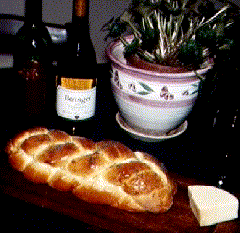 Challah
ChallahPersonally, I made it with instant-rise yeast. Following the yeast instructions, I mixed the yeast with half the flour, the sugar and the salt. To this I added the water (hot) and then enough flour to make the stiff dough (a bit over half of what was left) and immediately kneaded it for ten minutes. It then took only a bit over half an hour to double in size. After this point the instructions are the same. I don't know where she got those cooking times though. For the first loaf I tried to follow them and overcooked it pretty badly (no, not quite to burning). For the second loaf, I let it cook for about five minutes at the high temperature, then ten to fifteen at the lower one and it came out much nicer.
This braided loaf for the Sabbath and festivals is common among Ashkenazic, Italian, and ``true'' Sephardic communities. Only the Middle Eastern, North African, and Persian Jews do not have a braided bread for Sabbath and festivals.
Challahs are often braided in a complex way, but a simple 3-stranded braid is used here. A specially big challah shaped with several braids of different sizes is baked for a wedding, bar mitzvah, or other celebration; it is sugar-glazed and decorated with sprinkles. A round challah, made from a strip of dough wound into a snail shape, is traditional on the New Year to symbolize the continuing cycle of the years. Normally, two challah are baked at once and put on the Friday night table, covered with a cloth until the meal is about to start.
When baking challah containing more than three pounds of flour, break off a tiny piece of dough about the size of a walnut. Recite a blessing and burn the piece (formerly it was thrown into the fire). This is to symbolize the portion of bread that was given to the priests when the Temple stood in Jerusalem.
In a small bowl, combine the yeast with the sugar and 1/2 cup water. Cover with plastic and leave in a warm place until well-risen, about 20 minutes.
Sift the flour and salt into a warmed bowl. Make a well in the center and break the egg into it. Add the yeast mixture and stir with a wooden spoon, gradually incorporating the liquid into the flour. Gradually add enough remaining warm water to make a stiff dough. Turn the dough onto a floured board and knead until it is smooth and elastic, and it doesn't stick to your hands, about ten minutes. Put dough in a warmed, greased bowl. Cover it with plastic, and let rise until doubled, about two hours.
Punch down the dough and divide into six balls. Roll the balls between your hands into long strips of equal length and about one inch wide. Braid three strips together and place on a greased cookie sheet. Wrap the ends neatly underneath the loaf. Repeat with the remaining three strips to make another loaf. Cover the loaves with a kitchen towel and leave them in a warm place to rise for about 45 minutes. (Alternatively, put them in large plastic bags and leave them in the refrigerator overnight. Then let them rise the next day.)
Preheat the oven to 450°F. Brush the loaves with the beaten egg and water mixture and sprinkle with the seeds. Bake loaves for 15 minutes then reduce the heat to 375°F and bake for 40 minutes or until golden brown. Let cool on a rack.